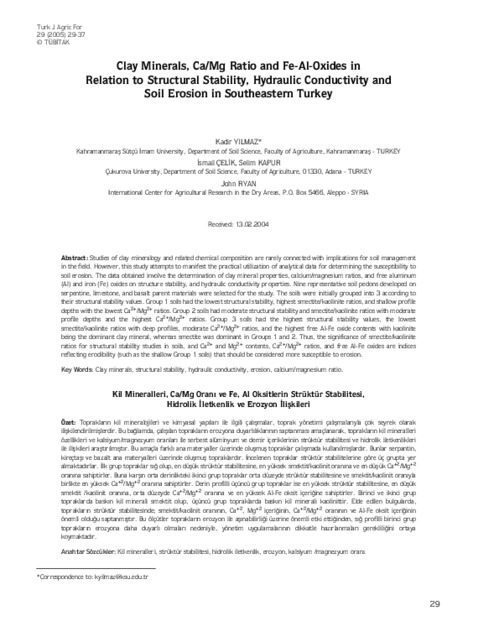Clay minerals, Ca/Mg ratio and fe-al-oxides in relation to structural stability, hydraulic conductivity and soil erosion in southeastern Turkey
Abstract
Studies of clay mineralogy and related chemical composition are rarely connected with implications for soil management in the field. However, this study attempts to manifest the practical utilization of analytical data for determining the susceptibility to soil erosion. The data obtained involve the determination of clay mineral properties, calcium/magnesium ratios, and free aluminum (Al) and iron (Fe) oxides on structure stability, and hydraulic conductivity properties. Nine representative soil pedons developed on serpentine, limestone, and basalt parent materials were selected for the study. The soils were initially grouped into 3 according to their structural stability values. Group 1 soils had the lowest structural stability, highest smectite/kaolinite ratios, and shallow profile
depths with the lowest Ca2+/Mg2+ ratios. Group 2 soils had moderate structural stability and smectite/kaolinite ratios with moderate profile depths and the highest Ca2+/Mg2+ ratios. Group 3 soils had the highest structural stability values, the lowest smectite/kaolinite ratios with deep profiles, moderate Ca2+/Mg2+ ratios, and the highest free Al-Fe oxide contents with kaolinite being the dominant clay mineral, whereas smectite was dominant in Groups 1 and 2. Thus, the significance of smectite/kaolinite ratios for structural stability studies in soils, and Ca2+ and Mg2+ contents, Ca2+/Mg2+ ratios, and free Al-Fe oxides are indices reflecting erodibility (such as the shallow Group 1 soils) that should be considered more susceptible to erosion

